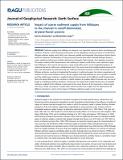Impact of coarse sediment supply from hillslopes to the channel in runoff-dominated, dryland fluvial systems
Abstract
Sediment supply from hillslopes to channels is an important control on basin functioning and evolution. However, current theoretical frameworks do not adequately consider processes of runoff-driven hillslope sediment supply, which affect river channels spatially and temporally. Mountainous dryland basins exhibit an important manifestation of these processes because their debris-mantled hillslopes produce coarse sediment and because rainfall is delivered as infrequent, high-intensity, short-duration rainstorms. This paper combines field measurements and modeling to explore runoff-driven coarse sediment supply from hillslopes to the channel and assesses a range of plausible storms on the longitudinal patterns of sediment load and its caliber over a dryland basin reach. Our results show that modeled sediment load and its grain size distribution are determined by the nonlinear interaction between rainfall characteristics and hillslope attributes, resulting in longitudinal fluctuations in sediment supply, the relative magnitude and location of which varies between storms. Results suggest that long hillslopes are most sensitive to rainfall and they exhibit large variations in supplied sediment load and grain size for different runoff characteristics. Short and steep hillslopes are less sensitive to rainfall variations as gradient effects dominate over the role of length in modulating runoff accumulation. Furthermore, the signal of the median fraction (D50) of modeled sediment supplied by the hillslope is preserved in the coarse fraction of the measured in-channel grain sizes (D90). Finally, we propose a simple index, which provides new insights into the effectiveness of different rainstorms in terms of the impact of hillslope sediment supply on the channel.
Citation
Michaelides , K & Singer , M B 2014 , ' Impact of coarse sediment supply from hillslopes to the channel in runoff-dominated, dryland fluvial systems ' , Journal of Geophysical Research - Earth Surface , vol. 119 , no. 6 , pp. 1205–1221 . https://doi.org/10.1002/2013JF002959
Publication
Journal of Geophysical Research - Earth Surface
Status
Peer reviewed
ISSN
2169-9011Type
Journal article
Collections
Items in the St Andrews Research Repository are protected by copyright, with all rights reserved, unless otherwise indicated.

